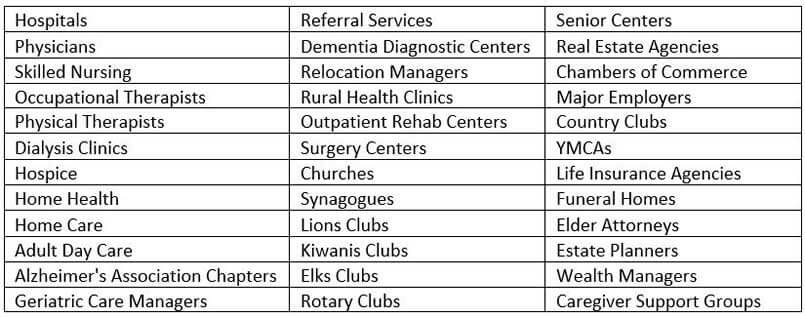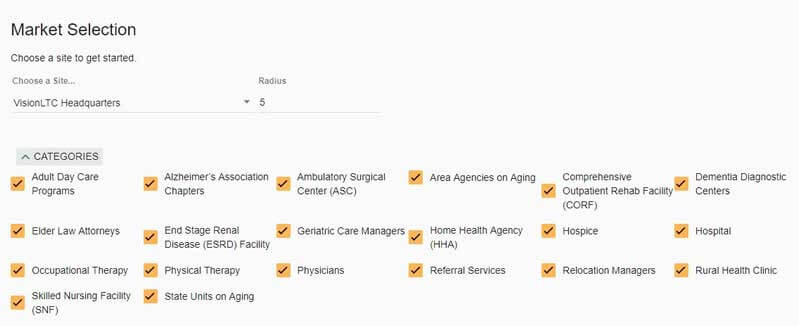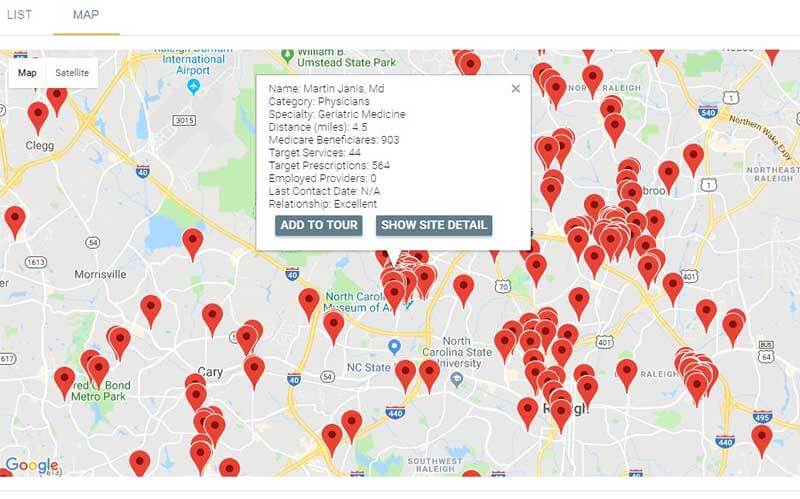Lead Generation In Senior Housing
February 13, 2018

Resident turnover is skyrocketing as a result of increasing acuity; so is the cost of replacing a resident, especially with referral sources like A Place for Mom. Conservative estimates suggest that resident turnover costs the average 100-unit AL/MC $175k/yr. So, what are you to do? Double down on professional referrals.
Research suggests that 70% of leads in assisted living come from professional referral sources, ranging from physicians to home health agencies, a number that is set to grow as acuity continues to increase. Even better, leads generated from these sources cost a fraction of the price of leads generated through other channels, such as A Place for Mom or print advertising.
SHORTCOMINGS IN CURRENT PROFESSIONAL REFERRAL SOURCE MANAGEMENT PRACTICES:
Despite the critical role that professional referrals play in seniorhousing, most operators do not manage their professional referral source relationships strategically. Over the past year, we’ve discussed referral source management with hundreds of senior housing operators and identified several common deficiencies in referral source management practices across the industry:
- Limited Prospecting: Most operators make an effort to engage the obvious referral sources – the local hospital, the local Alzheimer’s Association chapter, etc. But beyond the obvious targets, referral source relationships are one-off and reactive, rather than using data to segment and prioritize the referral source base: for example, finding the physicians who perform the most CT scans for dementia.Operators maintain relationships with those referral sources they have previously interacted with.
- Non-Personalized Messaging: When operators engage professional referral sources, they use the standard talking points – we have the best care, our residents are happy, etc. – instead of personalizing their message to the referral source with whom they are speaking. This is a violation of a basic tenet of Sales101: sell to your prospect’s needs. Rather than a standardized script, senior housing operators should focus on “What’s in it for this referral source?” and sell to that.
- Lack of Information Capture: Community outreach is typically managed by the marketing director—a high turnover position. The challenge here is that most operators lack a systematic approach to accrue the knowledge created when their marketing directors interact with local referral sources. So when that marketing director inevitably leaves, so does all the knowledge about the referral source relationship.
- Lack of Strategic Analysis: This lack of systematic information capture on referral source outreach activities makes analyzing the effectiveness and progress of those efforts nearly impossible. And without this analysis, organizations are unable to identify which processes work and which need to be improved.
BEST PRACTICES IN PROFESSIONAL REFERRAL SOURCE MANAGEMENT:
Given the ever-growing importance of professional referrals in senior housing, it is critical that senior housing operators move quickly to address these shortcomings through the adoption of a best-practice referral source management approach. Based on our conversations, we have identified several key best-practices in referral source management, including:
- Data-Driven Prospecting: By identifying all potential referral sources in the market and identifying which referral sources have the greatest potential referral volumes, operators can ensure that they are spending their scarce community outreach time on the most lucrative referral source opportunities.
Sample Referral Source Categories

- Data-Driven Messaging:
- Step 1: Understand what your target referral source cares about when referring to senior housing. For physicians, it’s likely the management of the quality measures that affect their reimbursement. For hospitals, it’s likely readmissions and other quality measures that affect their reimbursement.
- Step 2: Develop a message tailored around why your community is the best in the market at meeting THEIR needs as a professional referral source.

- Systematic Information Capture: Capture information about each referral source interaction in a systematic fashion.
- Who did you interact with (gatekeeper)?
- What were their concerns, feedback, etc.?
- What were their preferences – does the gatekeeper like chocolate doughnuts, etc.?
- Are they likely to refer to you?
- Analysis of Referral Source Management Efforts: Analyze the information that you capture about your referral source management efforts.
- What’s working and what’s not working?
- Strengths and weaknesses?
- Are we reaching enough prospects?
USING VISIONLTC TO IMPLEMENT A BEST-PRACTICE REFERRAL SOURCE MANAGEMENT SYSTEM:
VisionLTC has developed the senior housing industry’s first-ever comprehensive referral source management system – Referral Insight. This system was based on lessons learned from decades of experience in senior housing marketing and designed to offer a turn-key solution to senior housing providers looking to improve their referral source lead generation machine. To do this, VisionLTC’s Referral Insight system offers the following key capabilities:
Comprehensive Referral Source Database: VisionLTC has developed a comprehensive, nationwide database that contains more than 1 million Tier 1, 2, and 3 referral sources. This database also includes key data about each referral source type (i.e. physician, elder law attorney) that will allow your organization to identify, segment, and prioritize the referral sources surrounding your communities.

Referral Source Messaging Data: VisionLTC’s database includes a wide array of data to assist your organization in tailoring and customizing a marketing message for each individual referral source. Talk about how you’ll improve reimbursement for physicians, lower readmissions for hospitals, and enhance reimbursement for skilled nursing providers.
Referral Source Exploration & Planning Tools: Analyze each referral source – where are they located, how big is their practice, etc. Create referral source routes based on geography or provider type.

Referral Source Information Collection System: Capture key information about each referral source. Track visits, feedback, and other “local knowledge” about each referral source to improve subsequent interactions.
Referral Source Analytics: Analyze the intensity and progress of your referral source program. How many visits were completed with each provider type? What was the feedback in general?
NIC MAP Vision gives operators, lenders, investors, developers, and owners unparalleled market data for the seniors housing and care sector.
